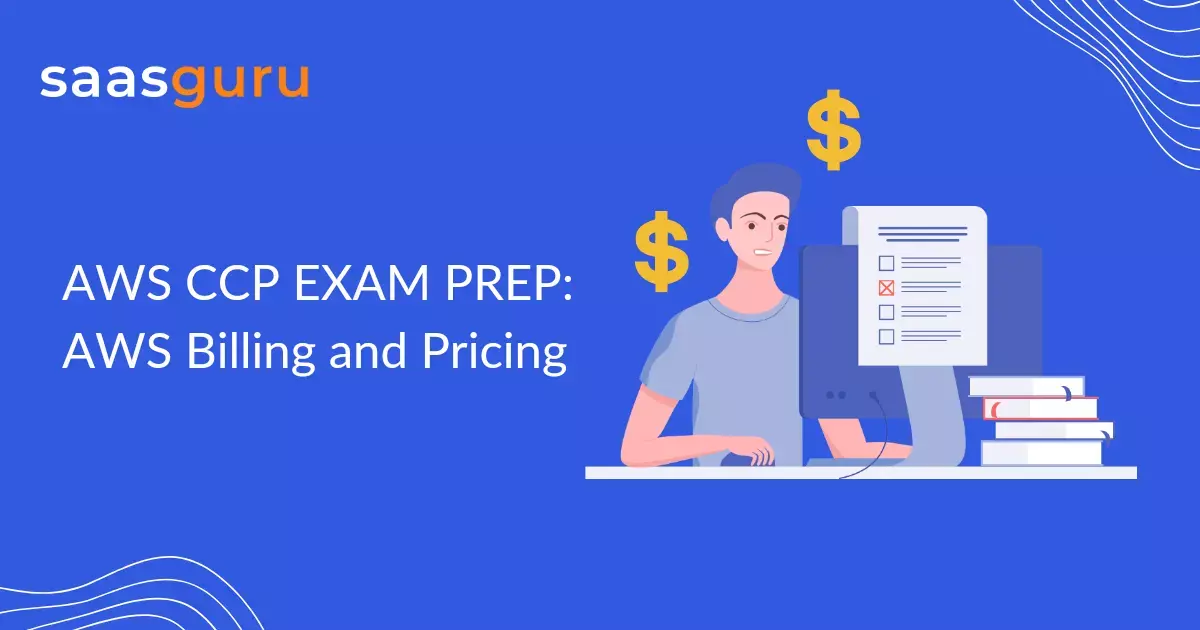AWS Billing and Pricing is a crucial topic in the AWS Certified Cloud Practitioner exam. Preparing for the AWS Certified Cloud Practitioner (CCP) exam requires a comprehensive understanding of AWS billing and pricing. It provides several features and benefits that can help you save money on your AWS bill and gives you greater control over your AWS usage.
This article will provide an overview of AWS billing and pricing aspects, including the different billing models, pricing tiers, the multiple discounts available, how it works, and its benefits. By understanding these topics, one can be better prepared for the CCP exam.
What is AWS Billing and Pricing?
AWS Billing and Pricing is a comprehensive system that allows you to manage your AWS costs and usage. It provides a detailed breakdown of your AWS charges and tools to help you budget for and optimize your AWS usage.
You can use AWS Billing and Pricing to pay for resources in various ways. You can pay for resources individually, or you can pay for them in a bundled way. You can also pay for resources in a variety of currencies.
AWS Billing and Pricing Basics
Pricing Tiers:
In order to satisfy the needs of various clients, Amazon Web Services (AWS) offers a number of pricing tiers. AWS pricing tiers are designed to allow customers to choose the best pricing model for their specific needs.
Different pricing tiers are as follows:
Use Coupon Code BLOG20 to avail flat 20% discount on saasguru Programs.
1. On-Demand Pricing
The On-Demand pricing tier is the most specific pricing model offered by AWS. This model allows customers to pay for computing resources as needed, with no upfront commitment or long-term contracts. Customers can scale up or down. They compute resources as needed and only pay for what they use. This makes On-Demand pricing ideal for customers who need the flexibility to quickly scale up or down as per their compute resources.
2. Reserved Instances
The Reserved Instances pricing tier is designed for customers who need a more predictable cost structure. With Reserved Instances, customers can purchase compute resources in advance and receive a discounted rate in exchange for a one or three-year commitment. This makes Reserved Instances ideal for customers who need a consistent level of computing resources over a long period.
3. Spot Instances
The Spot Instances pricing tier is designed for customers who need to save money on their computing resources. With Spot Instances, customers can bid on unused compute resources at a discounted rate. If their bid is accepted, they can use the calculated resources for as long as needed. This makes Spot Instances ideal for customers who need to save money on their computing resources but don’t need them for an extended period.
4. Dedicated Hosts
The Dedicated Hosts pricing tier is designed for customers who need dedicated physical servers for their computing resources. With Dedicated Hosts, customers can purchase dedicated physical servers reserved exclusively for their use. This makes Dedicated Hosts ideal for customers who need dedicated physical servers for their computing resources and don’t want to share them with other customers.
Types of Billing Cycles
AWS is a cloud computing platform that gives users access to a variety of services. It provides a variety of billing cycles to its customers, which allows them to choose the best option for their needs. The types of billing cycles offered by AWS are as follows.
1. Pay-As-You-Go
The Pay-As-You-Go billing cycle is the most flexible billing cycle offered by AWS. Thanks to this billing cycle, customers can pay for resources as they are utilized without making an upfront purchase or signing a long-term contract. Customers can compute resources as needed, scale up or down, and only pay for what they actually use. This makes Pay-As-You-Go billing ideal for customers who need the flexibility to quickly scale up or down.
2. Annual
The Annual billing cycle is designed for customers who want to receive a discount for paying for their resources upfront. With Annual billing, customers can pay for their computing resources in advance and receive a discounted rate. This makes Annual billing ideal for customers who need a more predictable cost structure and want to receive a discount for paying for their resources upfront.
3. Monthly
The Monthly billing cycle is designed for customers who want to pay for their resources every month. With Monthly billing, customers can pay for their computing resources every month. This makes Monthly billing ideal for customers who need a more flexible billing cycle and want to pay for their help monthly.
4. Usage-Based
The Usage-Based billing cycle is designed for customers who want to pay for their resources based on their usage. With Usage-Based billing, customers can pay for help based on their use. This makes Usage-Based billing ideal for customers who want to pay for their resources based on their actual usage.
Discounts
AWS Billing and Pricing offers a variety of discounts to customers that can help them save money on their cloud computing services. These discounts can be applied to various services, including EC2, S3, and RDS.
World Class Learning Experience from Anywhere
1. Reserved Instances
AWS offers Reserved Instances (RIs) to save customers money on Cloud Computing services. RIs are long-term commitments that allow customers to pay a discounted rate for their cloud computing services over some time. With RIs, customers can save up to 75% on their EC2, RDS, and Redshift services. Customers can also pay upfront or in installments over one or three years.
2. Spot Instances
Spot Instances are another type of discount offered by AWS Billing and Pricing. Spot Instances allow customers to bid on unused EC2 capacity at a discounted rate. If the customer’s bid is accepted, they can use the power for as long as needed. Spot Instances can be used for short-term or long-term workloads, and customers can save up to 90% on their EC2 costs.
3. Savings Plans
Savings Plans are another type of discount offered by AWS Billing and Pricing. Savings Plans allow customers to commit to a specific usage in exchange for a discounted rate. Customers can choose from either Compute Savings Plans or EC2 Instance Savings Plans. Compute Savings Plans offer discounts on EC2, Fargate, and Lambda services, while EC2 Instance Savings Plans offer discounts on EC2 instances. Customers can save up to 72% on their cloud computing costs with Savings Plans.
4. Volume Discounts
AWS also offers Volume Discounts for customers who use large amounts of Cloud Computing services. Volume Discounts are applied automatically when customers use more than a certain amount of services in a month. The amount of discount depends on the type of service being used and the amount of usage. With Volume Discounts, customers can save up to 45% on Cloud Computing costs.
How does AWS Billing and Pricing Work?
AWS Billing and Pricing are integral to the Amazon Web Services (AWS) platform. It is a complex system that can be difficult to understand, but it is essential to know how it works to make the most of the services offered by AWS.
AWS Billing and Pricing work in a few different ways. They are:
Credits: The first way is through AWS credits, which are given to customers who use AWS services. Credits can be used to offset the cost of future AWS usage, or they can be applied to your AWS bill.
Discounts: The second way is through AWS discounts, which are given to customers who sign up for long-term contracts with AWS. Discounts can be used to reduce the cost of future AWS usage, or they can be applied to your AWS bill.
Cost Estimation: Nextly, AWS provides customers with the ability to estimate their costs before they commit to using a particular service or resource. This allows customers to make informed decisions about their AWS usage and ensure they spend only what they need. Customers can use the AWS Simple Monthly Calculator to estimate their costs based on their usage and the services they plan to use.
Cost Analysis: AWS also allows customers to analyze their costs to identify areas where they can save money. Customers can use the AWS Cost Explorer tool to view their usage and costs over time and identify areas where they can optimize their costs. Additionally, customers can use the Trusted Advisor tool to identify opportunities for cost savings.
Cost Allocation: AWS allows customers to allocate costs across multiple accounts or projects. This will enable customers to track their usage and costs more accurately and make better decisions about their AWS usage. Customers can also track specific applications or service expenses using cost allocation tags.
Pricing and Billing Cycles: Finally, AWS Billing and Pricing can be used to pay for other services you use with AWS, such as Amazon S3 storage or Amazon EC2 instances.
Use Coupon Code BLOG20 to avail flat 20% discount on saasguru Programs.
Benefits Of AWS Billing and Pricing
- AWS Billing and Pricing have several benefits that make it an attractive option for businesses of all sizes. The most notable use is that AWS Billing and Pricing can save your business money.
- You can avoid having to make an upfront investment in pricey hardware and software by using AWS. Additionally, AWS can help you optimize your use of resources, which can further reduce your costs.
- Another benefit of AWS Billing and Pricing is its flexibility. With AWS, you only pay for the resources you use, so you can quickly scale up or down as needed. This has the potential to be a huge benefit for companies with varying demands.
- AWS also offers several tools to help you manage your billing and pricing. For example, the AWS Cost Explorer tool can help you track your costs and usage over time. This can be useful for identifying trends and making changes to your usage patterns.
- The AWS Budgets tool can also help you set and track your costs against those budgets. This can be useful for ensuring that you spend your AWS resources wisely.
- Finally, AWS Billing and Pricing provides transparency into your costs. You may optimize your utilization of AWS resources by looking at detailed billing reports to determine exactly where your money is going.
Summing Up
AWS Billing and Pricing provides a flexible and affordable choice for companies of all sizes. With its ability to save money, scale to meet your needs, and provide transparency into your costs, AWS Billing and Pricing is an attractive option for businesses looking to optimize resources.
AWS billing and pricing is a complex topic. Still, by understanding the different types of billing models, the different pricing tiers, and the various discounts available, you can be better prepared for the CCP exam.
Get AWS CCP certification exam training and mentoring from seasoned professionals by signing up with saasguru and be ready to climb the ladder of your career. You can also download the AWS learning app for Android or iOS to prepare for your AWS Certification exam from the comfort and convenience of your mobile.










